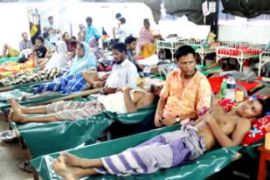Diarrhoea spreads after Asia floods
About 700 sufferers are checking into an overcrowded hospital in Dhaka every day.

“We are struggling to cope,” Prodip Bardhan, acting chief physician at the international centre for diarrhoeal disease research, said.
| In video | ||
|
Devastating monsoon floods have swept across South Asia in the past few weeks, with the focus now on combating a host of waterborne diseases, health officials said.
The floods are slowly receding in many areas but as they do animal carcasses rot, sewage festers and mosquitoes breed in the filthy water, spreading disease amongst exposed flood victims.
Across Bangladesh, two-thirds of which disappeared under flood waters in the last few weeks, about 100,000 people have caught dysentery or diarrhoea.
Pharmacists have been increasing the price of rehydration fluids, according to relatives of diarrhoea patients. Doctors at Dhaka‘s diarrhoea hospital said many patients were showing up malnourished, requiring extra treatment.
‘War-zone’
“It’s like a war-zone situation,” Alejandro Cravioto, the hospital’s executive director, said, as medical staff patrolled the tents with megaphones, urging patients to take their medication and stay hydrated.
“Some patients are very ill but the treatment is extremely effective,” he said.
 |
|
Sacks of food are being delivered to flood victims |
No one has died at the hospital since the outbreak, officials said, but 12 people have died from diarrhoea in rural districts of Bangladesh, according to reports.
In Assam state, in northeastern India, stagnant flood water will take up to two weeks to drain, aid workers say.
On the other side of the country in Gujarat, floods have caused drain pipes full of sewage to split. Health workers are disinfecting worst-hit areas.
“The stench is everywhere. Diseases could spread like wildfire,” S. Singh, a state rescue official, said.
Aid workers in Bihar, one of the worst-affected states, say the number of people with diarrhoea has jumped dramatically in recent days.
Several families camping on the side of the road near Gaighat hamlet said their children were racked with fever but they had no medicine, and doctors were yet to visit.
Aid deliveries
Government and aid agencies were delivering sacks of food and clean water in helicopters and boats, but demand has mostly outstripped supply.
“With limited assistance from governments, and humanitarian agencies overstretched, help is still a distant reality for many,” P.V. Unnikrishnan of ActionAid said in a statement.
“The response from the international community has been lukewarm. Time is running out – money is running out.”
But India has denied needing help from outsiders.
“Even after the tsunami, which was a tragedy of much bigger dimensions, India helped other countries and did not ask for any aid,” Onkar Kedia, home ministry spokesman said, referring to the 2004 tsunami in the Indian Ocean.
“It’s a big country and it can manage its own affairs.”
Several countries and international agencies have pledged assistance and money to help victims, including the European Union which has put up an initial $5.5m.
King Abdullah of Saudi Arabia ordered emergency supplies to be rushed to Bangladesh, the official SPA news agency reported on Thursday night, adding that $50m was being sent to cover urgent needs in the disaster zone.
Uunicef is working with officials in Bihar, hit by the heaviest flooding in 30 years, to conduct medical surveillance and inoculate children against disease, particularly measles.
